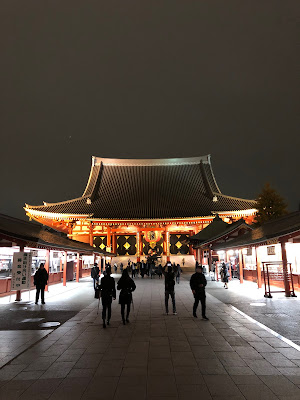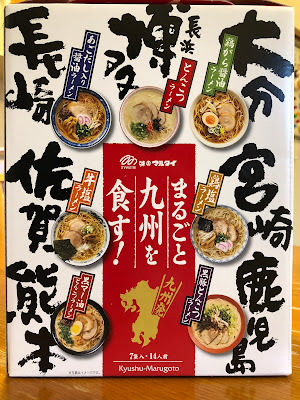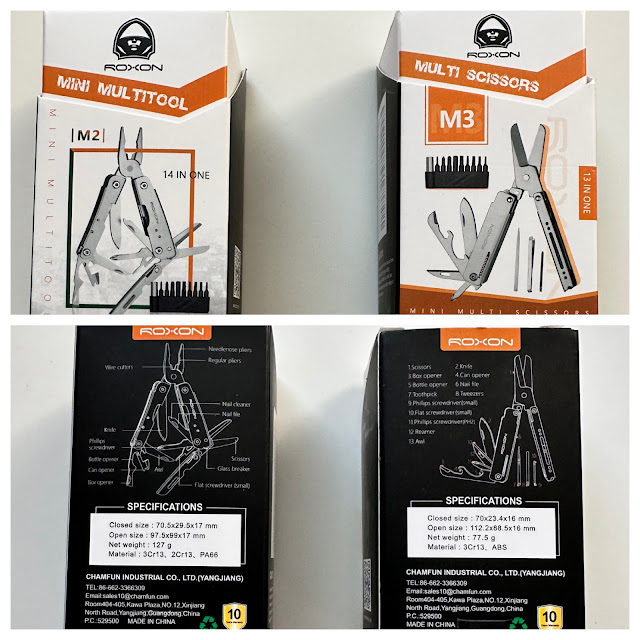Sensoji Temple - Tokyo Intro: Experience #37 of 55
 |
| Hondo at Sensoji Temple |
Sensoji is Tokyo's oldest temple and the major attraction in the Asakusa area. This large Buddhist temple dates back to 645 AD and is dedicated to the bodhisattva Kannon. There are also Shinto Shrines adjacent to the temple and the very popular Nakamise shopping street for traditional goods and souvenirs.
 |
| Kaminarimon or Thunder Gate (top) and Nakamise Dori (bottom) |
This shrine has over 30 million visitors every year and hosts Tokyo's most popular festival, the Sanja Matsuri in late spring. Visiting the temple is an experience that is different by night and day. People are praying and burning incense from morning until evening. During the day (after 11 AM) the area is bustling with shopping activity and tourists.
 |
| Hozomon |
 |
| Sensoji Pagoda |
At night, when the shops close, it is very atmospheric and you can get a more intimate experience around the temple grounds. All around the temple grounds are various shopping streets which all have their own unique shops.
- Most people enter the temple areas from the south through the impressive Kaminarimon or Thunder Gate. This gate has a massive paper lantern which everyone has their picture taken with. This iconic symbol of Askakusa has the words for Kaminarimon written on it. The lantern is huge with a height of four meters, a width of over three meters, and a weight of almost 700 kilograms. This lantern is replaced every ten years or so as it is made of paper and is even collapsible. Do look for the dragon on the underside of the lantern too!
- On either side of the lantern are two Shinto gods; Raijin, the god of thunder, is on the west side; Fujin, the god of wind is on the east side. These two gods are both imposing and impressive. After passing through the gate you are on Nakamise-dori and run a block long gauntlet of shops and food stalls which ends at the Hozomon Gate and the main temple grounds beyond.
- There is a five tiered pagoda here. It is the second highest pagoda in Japan at 53 metres in height. It was first built in 942, then reconstructed in 1648, and was last rebuilt in 1973 with a steel and concrete core. Inside the top level of the pagoda is a replica of the Buddha's ashes that were given by the Isurumuniya Temple in Sri Lanka in 1966.
- After passing through the Kaminarimon Gate you are on Nakamise Street. Nakamise Street is a wonderful place to find traditional souvenirs of Japanese Candy, various treats to eat, and plenty of handicrafts and little key chains and such. Many Japanese buy souvenirs here of their trip to Tokyo so the selection is really good. A treat to try is traditional sembei, a freshly roasted rice cracker dipped in soy sauce. Sembei are yummy and a 100 yen each! Try colorful candy like konpeito which is also the candy that was being fed to the soots in the movie Spirited Away. You can buy masks, fans, tea cups, lucky cats, little sumo wrestlers, etc., all on this street.
- At the end of Nakamise Street you see the Hozomon inner gate. This massive gate house has more giant lanterns and temple guardians called Nio. On the back side of the gate are giant straw sandals to show how powerful and large the guardians are.
- After this gate you are now in the main temple grounds where the hondo or main worship hall is. It is also called the Kannon-do as this is where the statue of Kannon is enshrined. The statue has been kept from public view since 645 as it is so sacred, but it also seems to bring bad luck when viewed.
- You can draw fortune sticks or omikuji here during the day. You donate a 100 yen, shake the container and have one stick drop out. The number on the stick tells you which fortune to take from numbered drawers. The fortunes are available in English. If you draw bad luck, tie it off at the racks nearby, so that the temple gods can take care of it for you. At the main hall you can make an offering of coins and pray to have your wish come true.
- Sensoji Temple and Nakamise Dori Visit
- Shinto Shrine Etiquette and Anime (Lucky Star Washinomiya Shrine)
- Meiji Jingu - The Imperial Shrine
- Kanda Myojin, The Love Live Shrine in Akihabara
- Atago Shrine and Toranomon Hills in Shimbashi
- Asakusa Tori No Ichi Shrine Festival
- Fushimi Inari Shrine Visit - A Shinto Fairy Tale
- Sensoji Temple
Back to Tokyo Intro - 55 Cool Sights and Experiences for Visitors
Follow me on Twitter a @Tostzilla or my feedburner.
More cup noodle / instant ramen reviews and Japanese pop culture.











Comments
Post a Comment